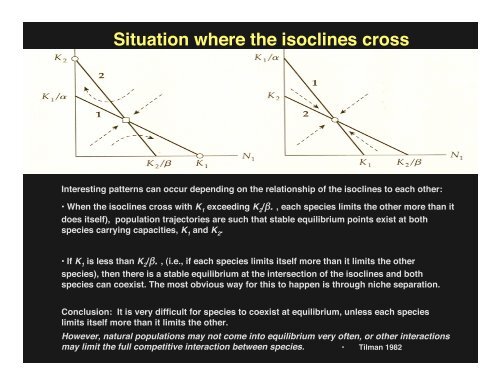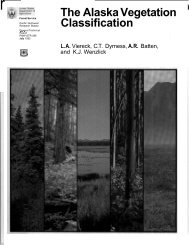Lectures on species interactions and competition
Lectures on species interactions and competition
Lectures on species interactions and competition
You also want an ePaper? Increase the reach of your titles
YUMPU automatically turns print PDFs into web optimized ePapers that Google loves.
Situati<strong>on</strong> where the isoclines cross<br />
Interesting patterns can occur depending <strong>on</strong> the relati<strong>on</strong>ship of the isoclines to each other:<br />
• When the isoclines cross with K 1<br />
exceeding K 2<br />
/ . , each <strong>species</strong> limits the other more than it<br />
does itself), populati<strong>on</strong> trajectories are such that stable equilibrium points exist at both<br />
<strong>species</strong> carrying capacities, K 1<br />
<strong>and</strong> K 2<br />
.<br />
• If K 1<br />
is less than K 2<br />
/ . , (i.e., if each <strong>species</strong> limits itself more than it limits the other<br />
<strong>species</strong>), then there is a stable equilibrium at the intersecti<strong>on</strong> of the isoclines <strong>and</strong> both<br />
<strong>species</strong> can coexist. The most obvious way for this to happen is through niche separati<strong>on</strong>.<br />
C<strong>on</strong>clusi<strong>on</strong>: It is very difficult for <strong>species</strong> to coexist at equilibrium, unless each <strong>species</strong><br />
limits itself more than it limits the other.<br />
However, natural populati<strong>on</strong>s may not come into equilibrium very often, or other interacti<strong>on</strong>s<br />
may limit the full competitive interacti<strong>on</strong> between <strong>species</strong>. • Tilman 1982
















